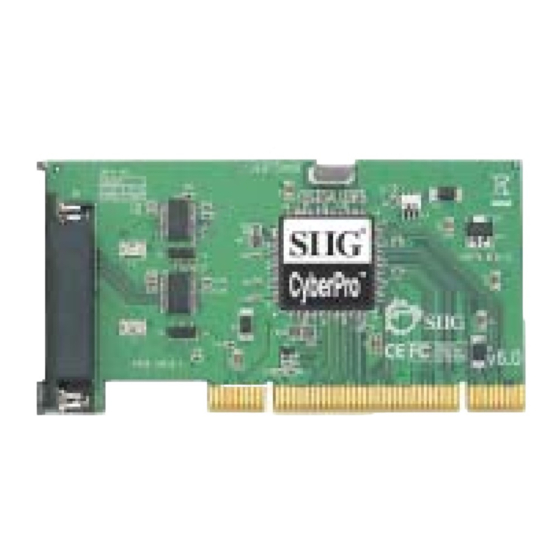
SIIG CyberSerial Dual PCI Quick Installation Manual
Hide thumbs
Also See for CyberSerial Dual PCI:
- Software installation (9 pages) ,
- Quick installation manual (12 pages) ,
- Quick installation manual (12 pages)
Table of Contents
Advertisement
Quick Links
Introducing the CyberSerial Dual PCI
The CyberSerial Dual PCI high-speed serial I/O card
provides two additional 9-pin serial ports. Depending
on the model purchased, this board will fit into either a
Full or Low Profile chassis.
Features and Benefits
•
Conforms to PCI v2.2 Plug and Play
•
Reduces CPU load and improves system
performance dramatically
•
IRQ sharing feature reduces IRQ conflicts
•
High-speed serial port (9-pin) works with 56K V.90
external modems, ISDN terminal adapters, PDAs,
digital cameras, label printers and other serial port
devices
•
Built-in FIFO buffers dramatically increase data
transmit/receive speed, especially under Windows'
multitasking environment
•
Each serial port can be configured for either 5V or
12V output, for serial devices that require power
System Requirements
•
Pentium
PCI slot
•
DOS, Windows
XP (32-/64-bit)/Server 2003 (32-/64-bit)/Vista (32/
64-bit)
•
Linux Kernel 2.4.x or later
04-0376B
CyberSerial Dual PCI
Quick Installation Guide
or equivalent computer with an available
®
95/98/98SE/ME/NT4.0/2000/
®
1
Advertisement
Table of Contents

Summary of Contents for SIIG CyberSerial Dual PCI
-
Page 1: Quick Installation Guide
CyberSerial Dual PCI Quick Installation Guide Introducing the CyberSerial Dual PCI The CyberSerial Dual PCI high-speed serial I/O card provides two additional 9-pin serial ports. Depending on the model purchased, this board will fit into either a Full or Low Profile chassis. -
Page 2: Package Contents
Package Contents • CyberSerial Dual PCI board • 2-port fan-out cable • Low profile bracket (Dual Profile board only) • Driver CD • Quick installation guide Layout JP2 (Serial port 2) Fan-out cable connector (25-pin) JP1 (Serial port 1) Figure 1. Layout * Note: Depending on the model purchased, the bracket size will be either Full or Low profile. -
Page 3: Hardware Installation
Fan-out Cable 9-pin serial 9-pin serial 25-pin connector Figure 2. Fan-out cable Hardware Installation General instructions for installing the card are provided below. Since the design of computer cases and motherboards vary, refer to your computer’s reference manual for further information, if needed. Static Electricity Discharge may permanently damage your system. -
Page 4: Driver Installation
25-pin connector. See Figure 2 on page 3 for more details. Driver Installation This section provides information on how to install the CyberSerial Dual PCI drivers. Boot up DOS and insert the driver CD. Copy OXSER.EXE from the DOS folder to your C: drive. - Page 5 Windows 95 At the Update Device Driver Wizard, click Next. Insert the driver CD, click Other Locations. Type in D:\9x, click OK, then click Finish. (Change D: to match your CD-ROM drive letter) From the Insert Disk window, click OK. When the Copying Files dialog box pops up, type in D:\9x, then click OK.
- Page 6 Right click My Computer, click Properties, then click Device Manager. Double click Ports (COM & LPT), CyberSerial PCI 16Cxxx... should be displayed two times. Double click Multi-function adapters, SIIG CyberPro 2S PCI board and PCI Function should be displayed. Windows NT 4.0 From the desktop click Start, then Run.
- Page 7 Windows 2000 At the Found New Hardware Wizard, click Next. Select Search for a suitable driver for my device (recommended), then click Next. Check Specify a location, uncheck the other boxes, then click Next. Insert the driver CD, type in D:\2000, then click OK. (Change D: to match your CD-ROM drive letter) Click Next and Finish.
- Page 8 For Windows Vista: Right click Computer, click Manage, click Continue, then click Device Manager. Click on the + (plus sign) in front of Ports (COM & LPT), CyberSerial 16Cxxx... should be displayed two times. Double click Multifunction adapters, a SIIG CyberPro serial board should be displayed.
- Page 9 Linux Kernel 2.4.x or later Open the terminal. Type setserial -bg /dev/ttyS* and hit Enter to show the current serial ports installed. SIIG board will be set up at the next available address. For example, if your system comes with /dev/ttyS0 and /dev/ ttyS1, set up SIIG board as /dev/tty2 and /dev/ ttyS3.
- Page 10 Changing COM Port Address Some serial devices need a specific COM port in order to work. If your serial device works properly, do not change this setting. Windows 95/98/98SE/ME From the Device Manager window double click Ports (COM & LPT), then double click the CyberSerial PCI serial port you want to change.
-
Page 11: Technical Support And Warranty
Step 1: Submit your RMA request. Go to www.siig.com, click Support, then RMA to submit a request to SIIG RMA. If the product is determined to be defective, an RMA number will be issued. Step 2: After obtaining an RMA number, ship the product. - Page 12 6078 Stewart Ave. Fremont, CA 94538-3152 CyberSerial Dual PCI is a trademark of SIIG, Inc. SIIG and the SIIG logo are registered trademarks of SIIG, Inc. Microsoft, Windows and Windows Vista are either registered trademarks or trademarks of Microsoft Corporation in the United States and/or other countries. Pentium is a registered trademark of Intel Corporation.










Need help?
Do you have a question about the CyberSerial Dual PCI and is the answer not in the manual?
Questions and answers